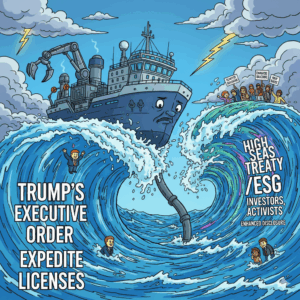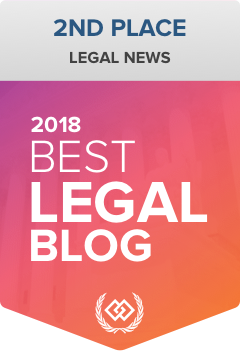Deep-Sea Mining, Public Market: Capital, Risk, and Regulatory Turbulence

Deep-Sea Mining and Capital Markets
As demand surges for strategic minerals like nickel, cobalt, manganese, and rare earths, deep-sea mining firms are increasingly turning to public markets as a path to raise the substantial capital needed for exploration, deepwater infrastructure, and subsea recovery systems. Listing on exchanges such as Nasdaq or the New York Stock Exchange (NYSE) provides access to institutional investors, liquidity, and reputational cachet—particularly useful in the capital-intensive and politically sensitive business of mining the ocean floor.
These listings may be executed via an initial public offering (IPO), a SPAC merger, a direct listing, or hybrid financing structures. However, the transition to public markets brings greater regulatory scrutiny, enhanced disclosure obligations, and higher governance expectations than in the private realm.
The Role of NYSE & Nasdaq

- Nasdaq is often viewed as more welcoming for growth and technology-oriented companies. Deep-sea mining ventures emphasizing robotics, automation, data analytics, or ocean tech may find Nasdaq’s image and flexibility more congenial.
- NYSE tends to attract issuers seeking to project durability, institutional legitimacy, and a strong anchor among long-term capital markets.
That said, listing on either exchange demands compliance with quantitative and qualitative standards—governing minimum market capitalization, public float, board composition, audit committee requirements, shareholder approvals, and internal controls. Deep-sea mining firms must incorporate into those standard criteria the disclosure of specialized risks, including regulatory uncertainty, international litigation, environmental opposition, technological feasibility risk, and dependencies on permits.
(Related resources on SecuritiesLawyer101: Nasdaq Listing Process, NYSE & Nasdaq Governance Standards, Independent Director Requirements)
Trump’s Executive Order on Deep-Sea Mining
A pivotal development in U.S. policy is President Trump’s Executive Order of April 24, 2025, titled “Unleashing America’s Offshore Critical Minerals and Resources.” The order directs NOAA and other agencies to expedite the issuance of licenses and permits under the Deep Seabed Hard Mineral Resources Act (DSHMRA), including in areas beyond U.S. jurisdiction.
The order marks the first serious attempt by the U.S. government to operationalize commercial deep-sea mining, signaling to companies and investors that the federal government supports efforts to counter China’s dominance in critical minerals.
Regulatory and Treaty Complexities

Instead, U.S. policy rests on the position that deep-sea mining in international waters is a “freedom of the high seas”, consistent with general principles of international law. By this logic, U.S. companies can lawfully proceed with exploration and recovery activities under domestic permits, even if ISA member states disagree.
This legal divergence is a double-edged sword:
- On the one hand, it allows U.S. companies to proceed without waiting for ISA exploitation regulations.
- On the other hand, it exposes them to geopolitical conflict, diplomatic disputes, and litigation risk from other nations, NGOs, or international forums seeking to assert ISA authority.
For public companies, this distinction must be clearly disclosed in offering documents, since it represents both a competitive advantage and a material litigation/regulatory risk.
The High Seas Treaty
The High Seas Treaty, also known as the Biodiversity Beyond National Jurisdiction (BBNJ) Agreement, adopted in 2023, establishes new frameworks for biodiversity protection in international waters, including environmental impact assessments, protected areas, and mechanisms for benefit-sharing.
Although the treaty does not directly prohibit mining, it sets precautionary standards that increase the scrutiny of seabed projects. While the U.S. has not ratified the treaty, investors, activists, and international partners may still pressure U.S. companies to adhere to its principles. Publicly traded firms will need to address this in ESG reporting and risk factor disclosures.
Strategic Implications
For deep-sea mining companies considering Nasdaq or NYSE listings:
- Highlight U.S. legal independence from ISA rules while acknowledging associated risks.
- Anticipate litigation under DSHMRA, where private parties may challenge NOAA permits or allege non-compliance.
- Integrate ESG frameworks aligned with the principles of the High Seas Treaty, even in the absence of U.S. ratification, to meet investor demand.
- Structure offerings carefully to comply with exchange standards and minimize dilution (see Nasdaq’s 20% Rule).
- Plan for ongoing financing through shelf registrations and secondary offerings (see Form S-3 Registration Guide).
Conclusion
Deep-sea mining sits at the intersection of resource strategy, international law, and capital markets. By accessing the Nasdaq or NYSE, companies can raise the capital needed to pioneer subsea resource extraction. However, they must also navigate a unique regulatory environment, including DSHMRA licensing without ISA oversight, Trump’s Executive Order expediting permits, and global pressure through the High Seas Treaty.
For issuers and investors alike, the opportunity is immense—but so are the risks.
If you have questions about taking your company public or would like to speak with a Securities Attorney, Hamilton & Associates Law Group, P.A. is ready to help. Our Founder, Brenda Hamilton, is a nationally known and recognized securities attorney with over two decades of experience assisting issuers worldwide with going public on the Nasdaq, NYSE, and OTC Markets. Since 1998, Ms. Hamilton has been a leading voice in corporate and securities law, representing both domestic and international clients across diverse industries and jurisdictions. Whether you are taking your company public, raising capital, navigating regulatory challenges, or entering new markets, Brenda Hamilton and her team deliver the experience, strategic insight, and results-driven representation you need to succeed.
To speak with a Securities Attorney, please contact Brenda Hamilton at 200 E Palmetto Rd, Suite 103, Boca Raton, Florida, (561) 416-8956, or by email at [email protected].
Hamilton & Associates | Securities Attorneys
Brenda Hamilton, Securities Attorney
200 E Palmetto Rd, Suite 103
Boca Raton, Florida 33432
Telephone: (561) 416-8956
Facsimile: (561) 416-2855
www.SecuritiesLawyer101.com






